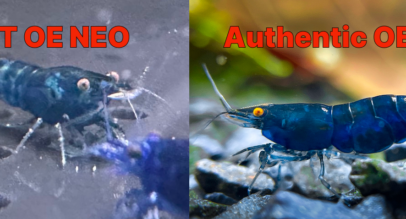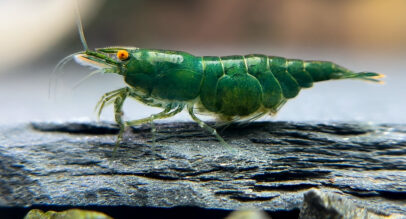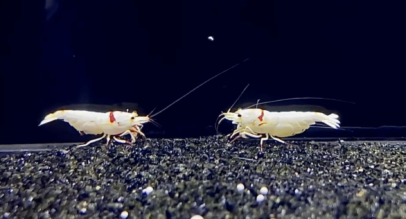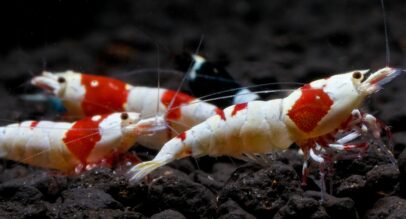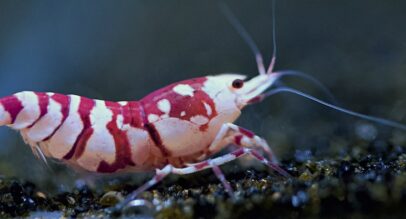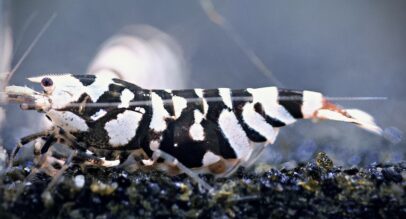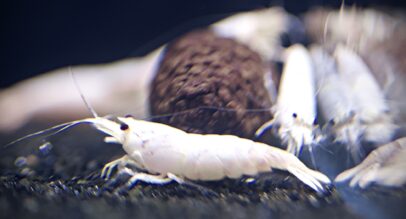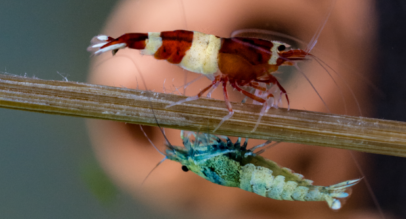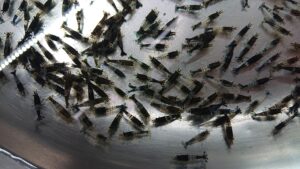 One of the most rewarding aspects of keeping Neocaridina Black Rili shrimp is watching a thriving colony develop its striking black and transparent patterns. While these hardy freshwater shrimp are generally less demanding than their Caridina cousins, providing proper nutrition plays a crucial role in their overall success. Unlike more sensitive species that require precisely calibrated diets, Black Rilis demonstrate impressive adaptability when it comes to food sources. However, this adaptability shouldn’t be mistaken for nutritional indifference – thoughtful feeding practices can make the difference between a merely surviving colony and one that truly flourishes.
One of the most rewarding aspects of keeping Neocaridina Black Rili shrimp is watching a thriving colony develop its striking black and transparent patterns. While these hardy freshwater shrimp are generally less demanding than their Caridina cousins, providing proper nutrition plays a crucial role in their overall success. Unlike more sensitive species that require precisely calibrated diets, Black Rilis demonstrate impressive adaptability when it comes to food sources. However, this adaptability shouldn’t be mistaken for nutritional indifference – thoughtful feeding practices can make the difference between a merely surviving colony and one that truly flourishes.
Consider the aquarium as not just a home for your shrimp, but as a complete ecosystem where every feeding decision ripples through the environment. The most successful Black Rili colonies thrive when we feed both the shrimp directly and nurture the biofilm and microscopic organisms that make up their natural grazing environment. This dual approach to nutrition mirrors their behavior in the wild, where they constantly graze on biofilm while opportunistically consuming larger food particles.
When it comes to breeding, proper nutrition serves as the foundation for success. Well-fed females produce healthier eggs with higher survival rates, while males maintain the energy reserves needed for successful mating behaviors. Just as importantly, juvenile shrimp require specific nutritional elements to support their rapid growth and development through multiple molting stages. Without adequate nutrition, breeding attempts may result in smaller clutch sizes, weaker offspring, or failed pregnancies altogether.
Perhaps most visibly, diet plays a fundamental role in both color development and maintenance in Black Rili shrimp. Their characteristic pattern of bold black sections contrasting with transparent areas requires specific pigment-supporting nutrients to develop properly. Poor nutrition can lead to faded coloration, uneven patterns, or loss of the prized transparent sections that make this variety so appealing. Beyond aesthetics, proper feeding directly influences their lifespan – well-fed shrimp not only live longer but maintain their vibrant appearance throughout their lives, often reaching ages of 1-2 years under optimal conditions.
Understanding these foundational aspects of Black Rili nutrition sets the stage for developing a feeding strategy that supports not just survival, but the development of a vibrant, breeding colony with exceptional coloration. In the following sections, we’ll explore specific dietary requirements and practical feeding approaches that will help your shrimp reach their full potential.
Core Feeding Philosophy for Black Rili Shrimp
The art of feeding Black Rili shrimp centers around an elegantly simple principle: less is often more. Think of your aquarium as a delicately balanced snow globe – every time we add food, we’re giving it a gentle shake. While some movement is necessary for life, too much disruption can cloud the waters both literally and metaphorically. This simple approach isn’t about limiting nutrition, but rather about delivering it in a way that maintains stability and promotes natural behaviors.
The relationship between feeding and water stability serves as the cornerstone of successful shrimp keeping. Every piece of food we add to the aquarium becomes part of a complex chemical equation. When food breaks down, it releases compounds that can affect water parameters such as ammonia, nitrates, and pH levels. Picture it like adding ingredients to a soup – each addition changes the overall flavor, and too much of any ingredient can overwhelm the broth. By feeding moderately and consistently, we allow the biological filtration system to process these nutrients efficiently, maintaining the stable environment that Black Rilis need to thrive.
This brings us to perhaps the most fascinating aspect of shrimp nutrition: the ecosystem approach. Rather than viewing feeding as simply putting food into the tank, we need to understand it as nourishing an entire microbiological community. Imagine your aquarium as a tiny forest – the shrimp aren’t just eating the fruit from the trees (your prepared foods), they’re also grazing on the moss, lichens, and tiny organisms growing on the bark (biofilm and microorganisms). When we feed thoughtfully, we’re not just feeding the shrimp directly; we’re providing nutrients that support the growth of biofilm, bacteria, and microorganisms that form a crucial part of their natural diet.
Understanding this ecosystem approach helps explain why successful shrimp keepers often maintain thriving colonies with what might seem like minimal feeding. The key lies in creating conditions where natural food sources can flourish alongside periodic supplemental feeding. This mimics the natural environment where Black Rilis evolved, allowing them to engage in their natural grazing behaviors while ensuring they receive complete nutrition.
Maintaining this balanced approach requires observation and patience. Watch how your shrimp interact with different surfaces in the aquarium – their constant grazing tells you about the health of your microscopic ecosystem. Notice how they respond to different foods and feeding amounts. Over time, you’ll develop an intuitive understanding of how your specific colony’s needs align with the overall ecosystem’s stability. This observational approach, combined with the principles of simplicity and stability, forms the foundation for successful long-term shrimp keeping.
Think of yourself not just as a keeper of shrimp, but as a curator of their entire world. Your feeding decisions ripple through the ecosystem, affecting water quality, bacterial colonies, biofilm development, and ultimately, the health and vitality of your Black Rili colony. By embracing this holistic view of nutrition, you’re setting the stage for a naturally balanced and thriving aquarium environment.
Essential Diet Components for Black Rili Shrimp
Understanding the core components of a Black Rili shrimp’s diet requires thinking about food not just as nutrition, but as part of the overall aquarium environment. Like any living creature, these shrimp need specific nutritional elements to thrive, but the way we deliver these nutrients matters just as much as the nutrients themselves.
Let’s start with the concept of the draw factor, which plays a crucial yet often overlooked role in shrimp nutrition. Think of the draw factor as the food’s “magnetic pull” on your shrimp. A food might be nutritionally complete, but if it doesn’t attract the shrimp, they won’t benefit from those nutrients. The best foods for Black Rilis combine strong attractants like natural proteins and plant matter that trigger their feeding response, encouraging them to quickly locate and consume the food before it can break down in the water.
Food stability represents another critical factor in shrimp nutrition. The “2-3 hour rule” serves as our guiding principle here: any food that remains in the aquarium longer than this window risks degrading water quality. Imagine dropping an ice cube into a glass of water – you want the ice to slowly melt and be consumed, not sit at the bottom creating a cold spot. Quality shrimp foods should maintain their structure long enough for consumption while gradually softening to allow efficient feeding. Foods that quickly dissolve or fall apart not only waste nutrients but can spike ammonia levels and disturb the careful balance of your aquarium.
Digestibility factors directly influence how effectively your shrimp can utilize the nutrients in their food. Black Rilis, like all invertebrates, need food particles small enough for their tiny mouthparts to process. The food should also be easily broken down by their digestive systems. Think of it like the difference between trying to eat an apple whole versus taking small bites – the nutrients might be identical, but the form matters tremendously for actual absorption.
When it comes to nutritional balance, Black Rilis require a mix of proteins, plant matter, minerals, and vitamins to support their various biological processes. Protein supports growth and molting, plant matter provides necessary fiber and micronutrients, while minerals like calcium are crucial for shell development. The ideal staple food provides these elements in appropriate proportions, typically with a protein content between 30-40% for adult shrimp.
Proper portioning and feeding methods can make or break your shrimp-keeping success. The golden rule is to feed only what your shrimp can consume within 2-3 hours. For a typical colony, this often means a portion about the size of a pea for every 20-30 adult shrimp. It’s better to feed smaller amounts more frequently than to overfeed, which can quickly lead to water quality issues.
For those seeking a reliable staple food that meets these requirements, Rare Shrimp Complete foods (available at: https://www.amazon.com/dp/B0DJR3XX3J) has developed a formula specifically designed for Neocaridina species like Black Rilis. Their food incorporates natural attractants, maintains stability in water while remaining highly digestible, and provides a balanced nutritional profile. The pellet size is optimized for shrimp feeding behavior, and the food’s water stability aligns well with the 2-3 hour feeding window recommended for optimal tank maintenance.
Remember that while having a quality staple food is essential, it should be part of a broader feeding strategy that includes variety and considers the overall ecosystem of your aquarium. This foundation of proper nutrition, combined with appropriate feeding techniques, sets the stage for vibrant colors, successful breeding, and a thriving Black Rili colony.
Biofilm Development for Black Rili Shrimp
To truly understand biofilm’s role in Black Rili nutrition, imagine your aquarium as a vast meadow where microscopic life flourishes on every surface. In nature, shrimp spend countless hours grazing on these invisible pastures, and recreating this environment in our aquariums proves essential for their wellbeing. This natural grazing behavior isn’t just about nutrition – it’s a fundamental part of how these creatures interact with their environment.
Think of biofilm as nature’s original superfood for shrimp. This microscopic community consists of bacteria, algae, fungi, and other microorganisms that form a thin, often invisible layer on all underwater surfaces. When Black Rilis graze on biofilm, they’re not just consuming one type of nutrition but rather accessing a complete microscopic ecosystem rich in proteins, enzymes, and essential compounds that support their health in ways that prepared foods alone cannot match.
For a thriving colony, healthy biofilm development serves as a cornerstone of success. Young shrimp, in particular, rely heavily on biofilm during their early development stages. Like human infants who need specific nutrients for proper growth, baby shrimp require the diverse micronutrients found in biofilm to develop strong exoskeletons and vibrant coloration. The presence of robust biofilm communities also helps stabilize water parameters naturally, as these beneficial microorganisms process waste and contribute to the nitrogen cycle.
Supporting healthy microorganism growth requires understanding the conditions these tiny life forms need to thrive. Just as a garden needs the right combination of sunlight, water, and nutrients, biofilm requires specific conditions to flourish. Moderate lighting, stable water parameters, and the presence of organic matter all contribute to healthy biofilm development. The key lies in finding the right balance – enough nutrients to support growth without overwhelming the system.
Several effective methods exist for promoting biofilm growth in your aquarium. First, consider adding natural materials like leaf litter or small pieces of wood, which provide excellent surfaces for biofilm colonization. These materials slowly decompose, releasing organic compounds that feed the microorganism community. Second, maintain consistent lighting periods that allow photosynthetic organisms within the biofilm to thrive. Third, ensure good water flow that delivers nutrients while preventing stagnant areas.
For those seeking to accelerate and optimize biofilm development, Rare Shrimp Biofilm Culture Bags (available at: https://www.amazon.com/dp/B0DKN8C231) offer a specialized solution. These carefully formulated culture bags work like slow-release nutrients specifically designed to promote beneficial biofilm growth. Think of them as feeding the food that feeds your shrimp – they provide the perfect blend of compounds that encourage healthy microorganism colonization without risking water quality issues that can come from other organic additives.
The placement of these culture bags requires strategic thinking. Position them in areas with good water flow but not directly in the current. This allows the beneficial compounds to disperse gradually while giving microorganisms a chance to establish themselves. For optimal results, consider placing multiple bags throughout the aquarium to create various grazing zones for your shrimp.
Remember that biofilm development is a gradual process that requires patience. Like establishing a natural garden, you can’t rush the growth of these beneficial microorganism communities. However, the reward for this patience comes in the form of healthier shrimp, more successful breeding, and a more stable aquarium ecosystem overall. When combined with appropriate prepared foods, a well-developed biofilm layer creates the ideal nutritional environment for your Black Rili colony to thrive.
Understanding and supporting biofilm development represents one of the most natural and effective ways to ensure your shrimp’s long-term health and vitality. By creating an environment that mimics their natural habitat, complete with abundant biofilm growth, you’re providing your Black Rilis with the foundation they need for optimal health, color development, and successful breeding.
Professional Feeding Schedule for Black Rili Shrimp
Developing a professional feeding schedule for Black Rili shrimp requires understanding the delicate balance between providing adequate nutrition and maintaining optimal water conditions. The alternating feeding approach represents a sophisticated method that addresses both the direct nutritional needs of your shrimp and the health of their supporting ecosystem.
The concept behind alternating feeding days stems from how natural aquatic environments function. In nature, shrimp experience varying levels of food availability, and their digestive systems have evolved to handle these fluctuations efficiently. By alternating between prepared food and microbial supplements, we create a rhythm that mimics these natural patterns while providing consistent nutrition.
On food days, using Rare Shrimp Complete Food (https://www.amazon.com/dp/B0DJR3XX3J) provides your colony with concentrated nutrition in a highly digestible form. Think of these days as providing the “main course” – the substantial nutrition that supports growth, molting, and color development. When feeding, remember that the food should be consumed within 2-3 hours. For a typical colony, start with a portion about the size of a pea for every 20-30 adult shrimp, adjusting based on your observation of their consumption patterns.
On alternating days, the Rare Shrimp Microbial Supplement (https://www.amazon.com/dp/B0DKN7H9LF) takes center stage. This supplement works differently from traditional food – instead of directly feeding your shrimp, it primarily nourishes the beneficial microorganisms in your aquarium. Consider it like adding fertilizer to a garden; you’re feeding the ecosystem that supports your shrimp. The microbial supplement helps maintain a healthy biofilm layer and supports the beneficial bacteria that process waste and maintain water quality.
This alternating schedule offers several key advantages. First, it prevents the accumulation of excess food and waste that could compromise water quality. Second, it ensures a consistent supply of nutrition while encouraging natural grazing behavior between feedings. Third, it supports the development of a robust ecosystem that provides supplementary nutrition through biofilm and microorganisms.
When implementing this schedule, consistency in timing becomes important. Try to feed at the same time each day, allowing your shrimp to develop regular feeding patterns. This consistency helps in monitoring consumption and adjusting portions as needed. Watch how your shrimp respond to each type of feeding – they should show active interest in the food while maintaining regular grazing behavior between feedings.
Remember that this schedule serves as a framework rather than a rigid rule. You’ll need to make minor adjustments based on your specific colony size, tank conditions, and the presence of other tank inhabitants. The key lies in observing your shrimp’s behavior and the tank’s overall health, then fine-tuning the feeding amounts and timing accordingly.
Building this routine takes time, but the results speak for themselves through healthier shrimp, more stable water parameters, and a more resilient ecosystem overall. The alternating schedule provides a professional approach to shrimp nutrition that supports both the immediate needs of your colony and the long-term health of their environment.
Observation Periods and Weekly Protocol for Black Rili Shrimp
Understanding and implementing proper observation periods in your Black Rili care routine transforms basic maintenance into a structured approach for optimal colony health. Think of these observation periods as regular health check-ups, where you’re not just feeding your shrimp but actively monitoring their response to different nutritional inputs and overall well-being.
The weekly protocol centers around a carefully timed supplementation schedule that works in harmony with your regular feeding routine. This systematic approach ensures your shrimp receive comprehensive nutrition while maintaining stable water parameters. The schedule follows a specific rhythm: Day 1 begins with regular feeding, Day 3 introduces the microbial supplement, Day 5 returns to regular feeding, and Day 7 combines the microbial supplement with vitamin supplementation.
When introducing Rare Shrimp Vitamins (https://www.amazon.com/dp/B0DKN58D6M) on Day 7, timing becomes particularly crucial. These vitamins serve as an immune system booster, much like how humans might take vitamin supplements to support their overall health. The best time to add these vitamins is during your regular observation period, when you can carefully monitor how your shrimp respond to the supplementation. Think of it as administering medicine – you want to be present to observe the immediate effects and ensure proper dosing.
The Rare Shrimp Biofilm Culture Bags (https://www.amazon.com/dp/B0DKN8C231) play a continuous role in this weekly protocol, working silently in the background to support the ecosystem. These bags slowly release beneficial compounds that promote biofilm development throughout the week, regardless of your feeding schedule. Consider them as the foundation of your nutritional approach, providing constant support for the microorganism communities that your shrimp depend upon.
During each observation period, pay particular attention to several key indicators. Watch how quickly your shrimp respond to food introduction – healthy shrimp should show immediate interest in food. Observe their grazing patterns between feedings – active grazing on tank surfaces indicates a healthy biofilm layer. Monitor molting frequency and the condition of shed exoskeletons, as these provide valuable insights into the effectiveness of your nutritional program.
The weekly schedule creates natural observation windows that help you develop a deeper understanding of your colony’s health:
Day 1 (Regular Feeding): Watch for feeding response times and general activity levels. Healthy shrimp should actively gather around food within minutes of introduction.
Day 3 (Microbial Supplement): Observe how your shrimp interact with tank surfaces after adding the supplement. You might notice increased grazing activity as the beneficial bacteria bloom.
Day 5 (Regular Feeding): Compare feeding behavior to Day 1. Consistent behavior between feeding days indicates stable colony health.
Day 7 (Microbial Supplement + Vitamins): This represents your most important observation period. The combination of supplements provides an excellent opportunity to assess overall colony vigor. Look for active movement, strong feeding response, and clear, vibrant coloration.
During these observation periods, take note of any changes in behavior, appearance, or water parameters. Keep a simple log of your observations – this can help identify patterns or potential issues before they become problems. Remember that subtle changes often provide early warnings of developing issues, making these regular observation periods crucial for maintaining long-term colony health.
Understanding and implementing this weekly protocol requires patience and attention to detail, but the benefits become evident through healthier shrimp, more successful breeding, and a more stable aquarium environment. By combining regular feeding with thoughtful supplementation and careful observation, you create optimal conditions for your Black Rili colony to thrive.
Common Pitfalls and Conclusion for Black Rili Shrimp Care
Understanding potential pitfalls in shrimp keeping helps prevent common mistakes that can impact colony health. Like any delicate ecosystem, a shrimp aquarium requires balance, and knowing what can disrupt this balance becomes crucial for long-term success.
Overfeeding represents perhaps the most common and dangerous pitfall in shrimp keeping. Many enthusiasts, driven by the desire to ensure their shrimp have enough to eat, inadvertently create problems through excessive feeding. When we add too much food to an aquarium, we’re not just giving our shrimp more than they need – we’re actively destabilizing their environment. Uneaten food breaks down, releasing ammonia and other compounds that can quickly overwhelm the tank’s biological filtration capacity. Think of it like filling a sink – even if the drain works perfectly, pouring in too much water too quickly will cause an overflow.
Supplement misuse presents another significant risk area. While products like vitamins and bacterial supplements can greatly benefit a healthy colony, they cannot fix fundamental problems in an unstable or uncycled aquarium. Using supplements in an unhealthy tank is like trying to treat symptoms without addressing the underlying illness. This becomes particularly important with vitamin supplementation – adding vitamins to a stressed or struggling colony can actually increase their stress levels rather than help them recover. The key principle here is that supplements should enhance an already stable environment, not attempt to compensate for poor conditions.
Parameter fluctuations often result from well-intentioned but misguided maintenance practices. Every time we add food, supplements, or even perform water changes, we risk disturbing the delicate balance of water parameters. These changes, while sometimes subtle, can significantly impact shrimp health. Shrimp are particularly sensitive to sudden changes in parameters like TDS (Total Dissolved Solids), GH (General Hardness), and pH. Making large adjustments quickly, even if moving toward “better” parameters, can stress or harm your colony.
Colony stress signals require careful observation to detect early. Watch for changes in behavior such as decreased activity, reduced feeding response, or shrimp gathering in unusual places. Physical signs might include dull coloration, irregular molting patterns, or decreased breeding activity. These signals often appear gradually, making regular observation crucial for early detection and intervention.
Success in keeping Black Rili shrimp ultimately revolves around maintaining stability in their environment. This stability encompasses everything from water parameters and feeding schedules to supplement use and maintenance routines. Think of your aquarium as a miniature world where every action creates ripples that affect the entire ecosystem. Small, consistent actions generally prove more beneficial than large, irregular changes.
The importance of observation cannot be overstated. Successful shrimp keeping requires developing an eye for detail and an understanding of your colony’s normal behavior patterns. Through regular observation, you learn to recognize subtle changes that might indicate developing problems. This observational skill becomes particularly valuable when introducing new foods or supplements, as it allows you to gauge their impact on colony health accurately.
Long-term success indicators extend beyond just survival or breeding. A truly thriving Black Rili colony displays vibrant coloration, consistent breeding activity, and regular molting. The shrimp should show active foraging behavior even between feedings, indicating a healthy biofilm layer and proper ecosystem function. Water parameters remain stable with minimal intervention, suggesting a well-established biological filtration system.
The journey to maintaining a successful Black Rili colony requires patience, consistency, and attention to detail. By understanding and avoiding common pitfalls while focusing on stability and careful observation, you create an environment where your shrimp can not just survive but truly thrive. Remember that each colony is unique, and success comes from understanding and working with the specific needs of your aquarium ecosystem.

